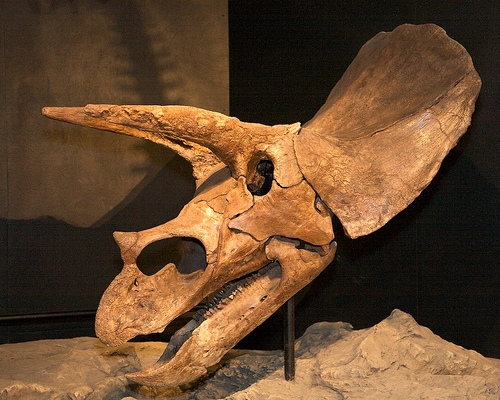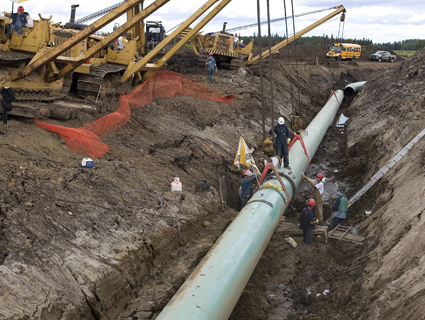
<a href="http://www.flickr.com/photos/etee/3302691513/sizes/m/in/photostream/">etee</a>/Flickr
The Keystone XL pipeline, which would transport oil from the Canadian tar sands to Texas refineries, is already unpopular, possibly unsafe, and almost certainly unclean, but a closer look at the pipe’s planned path reveals that it might also be stepping on some very old toes—65 million years old, in fact.
More than 100 miles of the proposed path cuts across one of the nation’s richest fossil fields, InsideClimate News reports. The Hell Creek Formation, which covers a large swath of southeastern Montana, is famous for its prodigious supply of triceratops fossils. (Many other prehistoric creatures, including T-rex and the aquatic plesiosaur, have also been found nearby.) As the pipe is laid underground in the area, the excavation is practically guaranteed to unearth all kinds of old bones, according to George Stanley, a University of Montana paleontologist. Unless they are protected properly, he adds, most fossils will start decomposing shortly after being exposed to air.
Given this, you might expect to see America’s paleontologists raising pickaxes in protest, but not so fast. “Paleontologists are looking at this as a double-edged sword,” Stanley told me. “The reaction is pretty much polarized.”
That’s because such a massive dig could also be a great opportunity to find cool stuff. “We paleontologists like it when people dig holes in the ground,” notes Montana State University paleontologist John Horner. But not all of them, apparently. Here’s InsideClimate News:
Paleontologist Peter Larson fears the construction equipment will grind up everything in its path. “The machines move so fast … [any fossils] will go through the shredder,” he said.
 Hell Creek formation and surrounding area. From “Hell Creek Formation: A 2001 Synthesis,” Kirk Johnson et al
Hell Creek formation and surrounding area. From “Hell Creek Formation: A 2001 Synthesis,” Kirk Johnson et al
Central to the debate is whether paleontologists will get to supervise the excavation; Stanley is worried that TransCanada, the Canadian behemoth behind the project, might substitute archeologists—who may fulfill the legal requirement for monitoring the pipeline’s impact, but are more focused on ancient dwellings or artifacts than fossils—for paleontologists. However, in an email statement, a TransCanada spokesman said:
Paleontological monitors will be monitoring construction for paleo resources in the entire Hell Creek formation… [Local legal] conditions require us to cease work at the location where the fossils were found, assess them for significance, and develop a plan for agency approval to address how to treat the fossils. One option is to move the route to avoid the resource.
Indeed, the paleontologist Paul Murphey, who authored a report on the region for the US State Department last year, told InsideClimate News that the route has already been changed several times based on his recommendations. The report details the pipe’s potential paleontological impact and identifies the Hell Creek formation as particularly sensitive, but suggests that the pipeline is unlikely to pass through any new, unidentified fossil fields.
The Obama administration has yet to approve the pipeline officially, although the State Department recently issued a statement claiming the environmental impact would be minimal, a position hotly contested by leading climate scientists. One way or the other, “paleontologists should be involved,” Stanley says. “It’s a fossil wonderland.”
Must read: Josh Harkinson’s feature story, “Scenes From the Tar Wars.”












